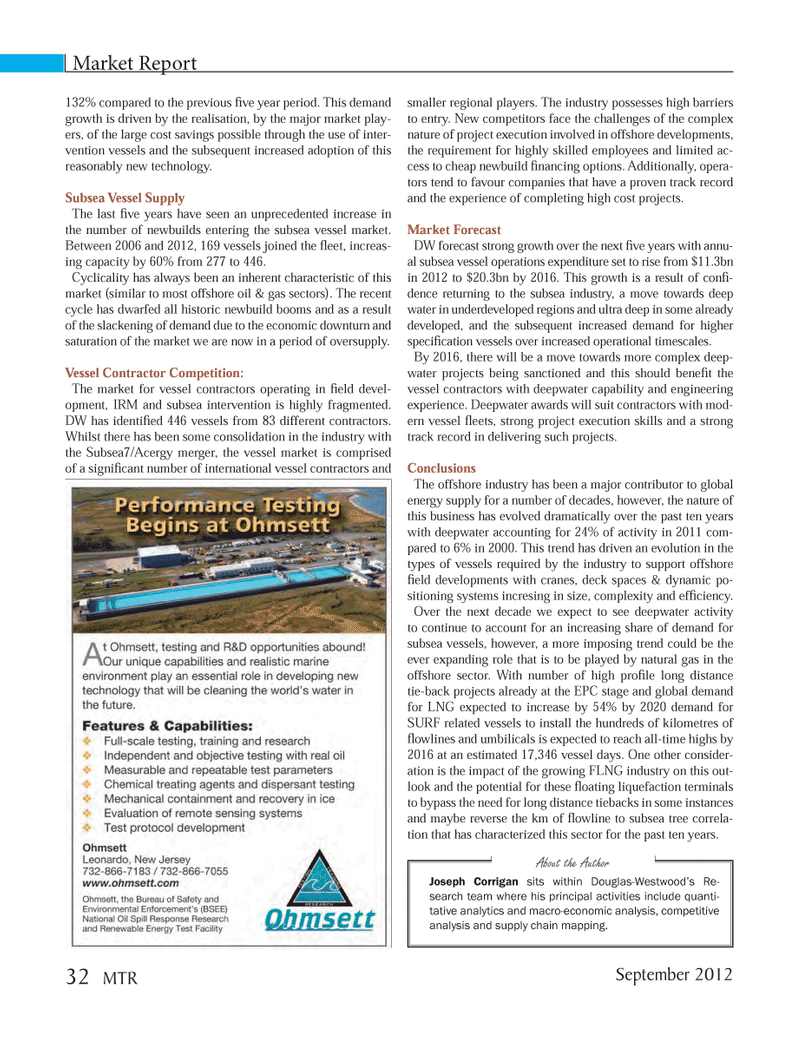
Page 32: of Marine Technology Magazine (September 2012)
Subsea Defense: Protecting Port & Subsea
Read this page in Pdf, Flash or Html5 edition of September 2012 Marine Technology Magazine
132% compared to the previous Þ ve year period. This demand growth is driven by the realisation, by the major market play- ers, of the large cost savings possible through the use of inter- vention vessels and the subsequent increased adoption of this reasonably new technology. Subsea Vessel Supply The last Þ ve years have seen an unprecedented increase in the number of newbuilds entering the subsea vessel market. Between 2006 and 2012, 169 vessels joined the ß eet, increas- ing capacity by 60% from 277 to 446. Cyclicality has always been an inherent characteristic of this market (similar to most offshore oil & gas sectors). The recent cycle has dwarfed all historic newbuild booms and as a result of the slackening of demand due to the economic downturn and saturation of the market we are now in a period of oversupply. Vessel Contractor Competition: The market for vessel contractors operating in Þ eld devel- opment, IRM and subsea intervention is highly fragmented. DW has identiÞ ed 446 vessels from 83 different contractors. Whilst there has been some consolidation in the industry with the Subsea7/Acergy merger, the vessel market is comprised of a signiÞ cant number of international vessel contractors and smaller regional players. The industry possesses high barriers to entry. New competitors face the challenges of the complex nature of project execution involved in offshore developments, the requirement for highly skilled employees and limited ac- cess to cheap newbuild Þ nancing options. Additionally, opera- tors tend to favour companies that have a proven track record and the experience of completing high cost projects. Market Forecast DW forecast strong growth over the next Þ ve years with annu- al subsea vessel operations expenditure set to rise from $11.3bn in 2012 to $20.3bn by 2016. This growth is a result of conÞ -dence returning to the subsea industry, a move towards deep water in underdeveloped regions and ultra deep in some already developed, and the subsequent increased demand for higher speciÞ cation vessels over increased operational timescales. By 2016, there will be a move towards more complex deep- water projects being sanctioned and this should beneÞ t the vessel contractors with deepwater capability and engineering experience. Deepwater awards will suit contractors with mod- ern vessel ß eets, strong project execution skills and a strong track record in delivering such projects. ConclusionsThe offshore industry has been a major contributor to global energy supply for a number of decades, however, the nature of this business has evolved dramatically over the past ten years with deepwater accounting for 24% of activity in 2011 com- pared to 6% in 2000. This trend has driven an evolution in the types of vessels required by the industry to support offshore Þ eld developments with cranes, deck spaces & dynamic po- sitioning systems incresing in size, complexity and efÞ ciency. Over the next decade we expect to see deepwater activity to continue to account for an increasing share of demand for subsea vessels, however, a more imposing trend could be the ever expanding role that is to be played by natural gas in the offshore sector. With number of high proÞ le long distance tie-back projects already at the EPC stage and global demand for LNG expected to increase by 54% by 2020 demand for SURF related vessels to install the hundreds of kilometres of ß owlines and umbilicals is expected to reach all-time highs by 2016 at an estimated 17,346 vessel days. One other consider- ation is the impact of the growing FLNG industry on this out- look and the potential for these ß oating liquefaction terminals to bypass the need for long distance tiebacks in some instances and maybe reverse the km of ß owline to subsea tree correla- tion that has characterized this sector for the past ten years. Market Report About the AuthorJoseph Corrigan sits within Douglas-Westwood?s Re- search team where his principal activities include quanti- tative analytics and macro-economic analysis, competitive analysis and supply chain mapping.September 201232 MTRMTR #7 (18-33).indd 32MTR #7 (18-33).indd 329/10/2012 9:34:20 AM9/10/2012 9:34:20 AM

 31
31

 33
33
